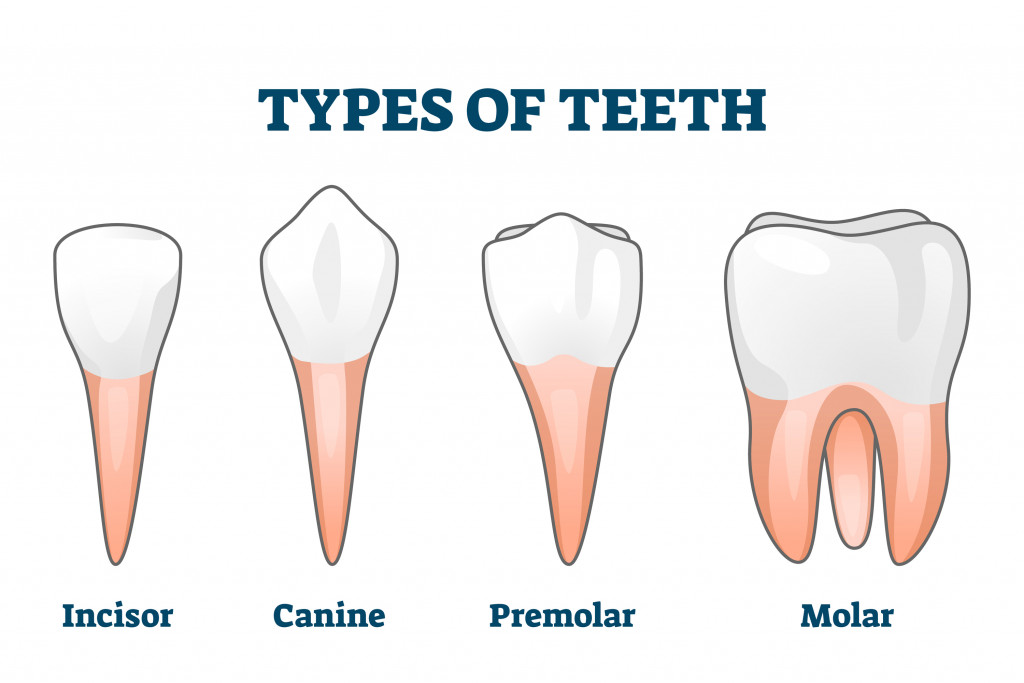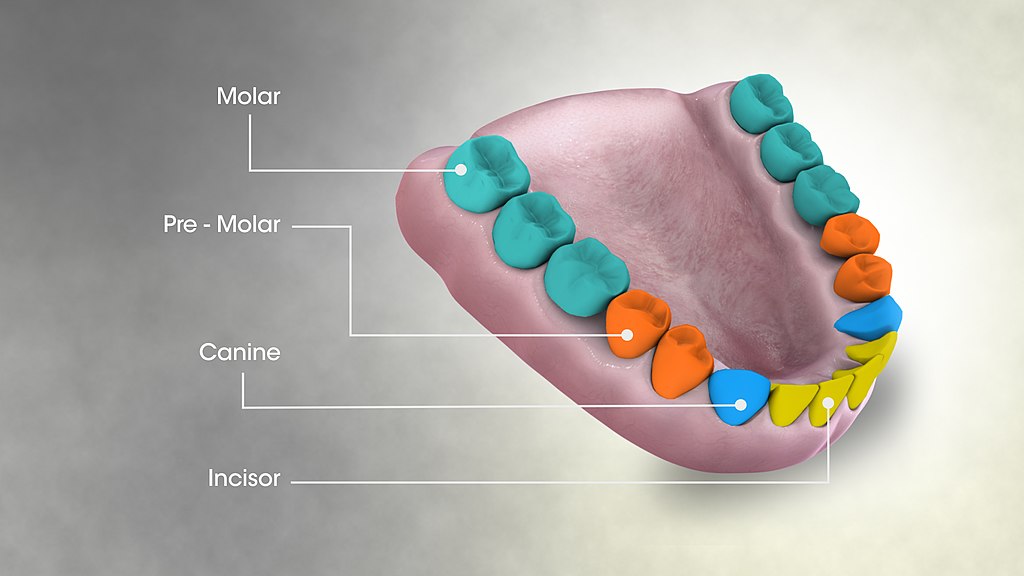Table of Contents (click to expand)
Each type of tooth (incisors, canines, premolars, and molars) serves a different purpose, from nibbling to tearing apart food items for digestion.
Have you ever looked in the mirror and wondered why our teeth are different shapes and sizes?
Teeth help us to break down bits of food, pronounce words, and give structural shape to our face. The different types of teeth in our mouth have special roles, hence their variation. Let’s dive into the different types of teeth and the benefits of the sets of teeth we have!

Types Of Teeth
The shape of each tooth gives it a specialized function for chewing food.
8 Incisors
The front-most teeth in your mouth are called incisors. There are four of them in the upper and lower jaws, totaling eight in number. These teeth are flat and thin, shaped like chisels. Incisors help you cut and bite food into smaller pieces as you begin the chewing process. They also help you pronounce words and support your lips and facial structure.
4 Canines
Canines are the sharp, pointed teeth that sit beside the incisors. There are two each in the upper and lower jaws—four in total. They are long and pointed, and are essential for gripping and tearing food items, such as meat. This is why canines are better developed in carnivores, such as lions and tigers… and in the fictional world, even vampires!
8 Premolars
Premolars are larger, flatter teeth that extend towards the back of your mouth, located behind the canines. These teeth have a flat surface with ridges. Premolars help to chew and grind food, making it small enough to swallow. Fully grown adults usually have 8 premolars in their mouths. Four are located on the top and four are located on the bottom. Young children do not have premolar teeth. These first appear as permanent teeth when children are 10-12 years old.
8-12 Molars
Molars are the biggest of all our teeth. They boast a large, flat surface with ridges that allow them to chew food and grind it up. Adults have 12 permanent molars, six on the bottom and top jaw, while children have eight primary molars.
The last molars to erupt are wisdom teeth, or third molars, which usually come through between the ages of 17- 21. These sit at the end of the row of teeth, in the far corners of the jaw. Some people do not have all four wisdom teeth, or the teeth may remain unerupted in the bone and never appear in the mouth.

Also Read: Where Do Teeth Come From?
Temporary Teeth Vs. Permanent Teeth
The number and types of teeth a person has changes as they age. Typically, people have two sets of teeth during their life: primary, or baby teeth, and permanent, or adult teeth.
At around six months of age, infants develop their first pair of deciduous teeth, also called milk teeth or baby teeth. New deciduous teeth continue to erupt every one to two months until the baby is around two years old and has a full set of deciduous teeth. These are temporary, hence, the name deciduous.
As the permanent teeth grow in the bone below the deciduous teeth throughout childhood, the roots of the deciduous teeth begin to be absorbed into the gums. This loosens them and allows them to fall out, making room for the permanent teeth to take their place. These permanent teeth are also called adult teeth. Children usually begin to lose their teeth starting around age six and the process finishes around age 12.
Our permanent teeth include the incisors, canines, premolars and molars. The set of temporary (baby) teeth do not have premolars. The teeth that replace the deciduous molars are called the first and second premolars. Since the jaw bones grow throughout puberty, extra space is made for the molars to occupy. The first permanent molars usually appear around age six, while the second permanent molars appear around age 12.
The third permanent molars, or wisdom teeth, usually don’t erupt until around the ages of 17 to 25, but sometimes they never erupt—remaining impacted in the jaw—or simply aren’t present at all. Altogether, that makes 32 permanent teeth!
While there are 20 deciduous teeth, there are 32 permanent teeth for the average adult.

Also Read: Do Animals Need To Brush Their Teeth Like Humans?
A Final Word
The different types of teeth—incisors, canines, premolars and molars—all play unique and important roles in helping us properly chew our food and break it down for digestion. Teeth also help in pronouncing words and giving shape to our face. We have two sets of teeth in a life time—a temporary set of 20 teeth and a permanent set of 32 teeth.
How well do you understand the article above!

References (click to expand)
- Anatomy and physiology of the teeth - Osmosis. .Org
- Chaurasia B. D. (2015). Bd Chaurasia's Handbk Gen Anatomy 5e. CBS Publishers & Distributors Pvt. Limited
- Netter F. H. (2018). Atlas of Human Anatomy. Elsevier
- Tortora G. J.,& Derrickson B. H. (2018). Principles of Anatomy and Physiology. John Wiley & Sons
